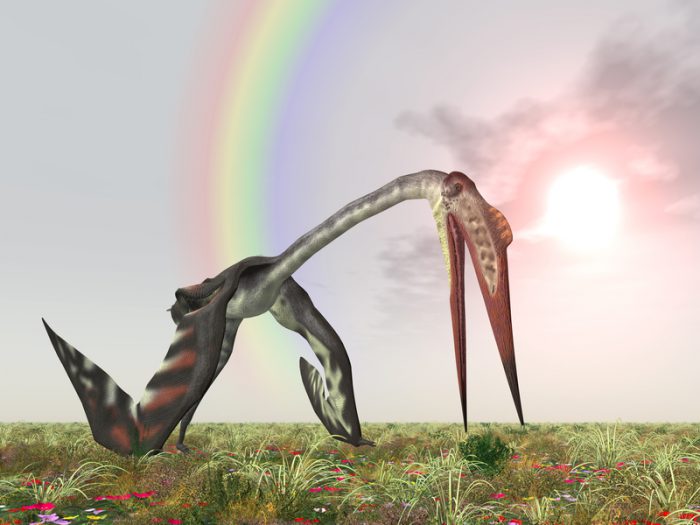On Friday, March 23, the Altmühltal Dinosaur Museum in Bavaria, Germany unveiled a skeleton of the biggest pterosaur ever discovered. It was found in Romania, which led researchers to nickname it Dracula (the vampire legend was set in Transylvania, a historical territory in Romania). No doubt, Dracula was about a scary as its namesake.
This beast stood about as tall as a giraffe when upright and weighed around 500 kilograms (1,100 lbs.). Its wingspan? A nifty 12 meters (39 feet) wide—possibly even wider! It was also a heavier-set animal than many other pterosaurs. Its neck bones were as wide as the body of a full-grown man. Listen to paleontologists describe their shock at finding the fossil in this video.
Factor in Dracula's exceptionally long, large head, and you've got a 66-million-year-old predator that no one would be happy to see swoop down from the skies above ...
... unless that never actually happened.
To fly or not to fly
Bringing Dracula to life ... (not really!) (Getty Embed)
Pterosaurs were prehistoric flying reptiles, right? Well, the second word in that description is actually a point of strong argument. Yes, generally speaking, pterosaurs flew. Their thin, hollow bones, light bodies, and wide wings made them ground-breaking animals in the world of non-insect flight.
But more and more scientists are concluding that the biggest pterosaur species—such as Quetzalcoatlus and our spooky friend Dracula here—could not fly. They simply would've been too heavy to do it. (Remember those human-wide neck bones we were mentioning earlier?)
Pterosaur scientists claim that this is not true, but it creates a real tug-of-war of scientific logic. The more muscular a giant pterosaur was, the more power it would have to propel its wings ... but those bigger muscles would make it heavier, meaning it would need even bigger muscles than that to take off ...
The guessing game continues
Assembling the biggest pterosaur for viewing. (Getty Embed)
Of course, when dealing with any extinct species, we can never know anything with 100% certainly. You can't observe an animal that doesn't exist. But among prehistoric reptiles from the Age of the Dinosaurs, pterosaurs are especially tricky. Their thin bones are far more fragile that those of their land and water-based relatives, so they disintegrate easily.
In the end, the most agreed upon theory of giant pterosaurs like Dracula is that they flew great distances as younger animals. It would have been their best defense as relatively fragile creatures. As they aged, however, they became more and more land-based. Eventually, they would've lived more as ostriches, becoming the apex, or top, predators of their region.
Sure enough, the paleontologists behind Dracula believe that the area they found him in was once an island. Now larger carnivorous dinosaur fossils have been found there, meaning this pterosaur probably ruled the roost. What do you think? Could a half-ton animal like Dracula really fly?
 A new discovery appears to surpass even the giant Quetzalcoatlus as the largest pterosaur ever known. (Mr1805 | Dreamstime.com)
A new discovery appears to surpass even the giant Quetzalcoatlus as the largest pterosaur ever known. (Mr1805 | Dreamstime.com)










This dinosaur Can Fly. It Has Wings. It Has a Big Beak Like a Bird. IT is cute.
I have NO IDEA that if THIS dinosaur FLY 😆